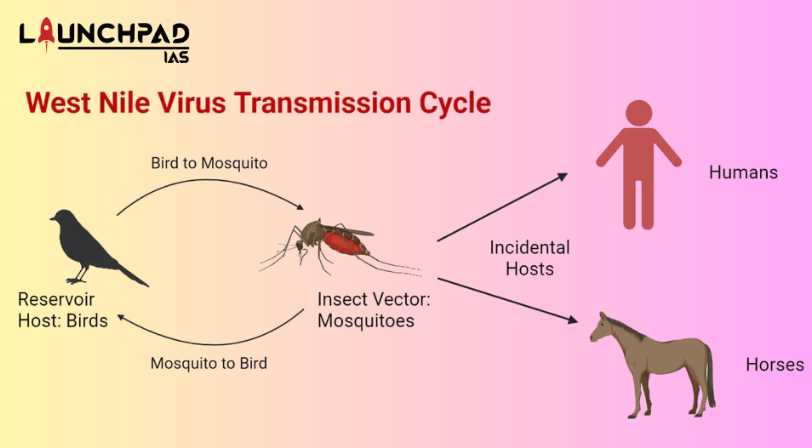About
- The West Nile Virus is a flavivirus related to the viruses that are also responsible for causing St. Louis encephalitis, Japanese encephalitis, and yellow fever.
- It is a mosquito-borne, single-stranded RNA virus.
Global Prevalence
- Along all major bird migratory routes, West Nile Virus outbreak sites are found.
- Africa, Europe, the Middle East, North America, and West Asia are the regions where the virus is commonly found.
- Usually, WNV infections peak during the period when mosquito vectors are most active and the ambient temperature is high enough for virus multiplication for most of the countries.
Prevalence in India
- In Mumbai in the year 1952, the antibodies against West Nile Virus were first detected in humans.
- Since then, the virus activity has been reported in southern, central, and western India.
- In Andhra Pradesh and Tamil Nadu, WNV was isolated from Culex Vishnui mosquitoes.
- In Maharashtra, it was isolated from Culex quinquefasciatus mosquitoes.
- In Karnataka, it has been isolated from humans.
- Further, WNV-neutralizing antibodies were found to be present in human serum collected from Tamil Nadu, Karnataka, Andhra Pradesh, Maharashtra, Gujarat, Madhya Pradesh, Odisha, Rajasthan and Assam.
- In 1977, 1978, and 1981, serologically confirmed cases of WNV infections were reported in Vellore and Kolar districts, and in West Bengal in 2017.
- During an acute encephalitis outbreak in Kerala, the complete genome sequence of WNV was isolated in 2013.
- The association of West Nile Virus with eye infection in Tamil Nadu had been clearly established during an epidemic of mysterious fever in the first half of 2010.
Origin
- West Nile Virus was first isolated in a woman in the West Nile district of Uganda in 1937.
- It was identified in birds in the Nile Delta region in 1953. Before 1997, WNV was not considered pathogenic for birds.
- Human infections attributable to WNV have been reported in many countries for over 50 years.
How does it spread?
- Culex species of mosquitos act as the principal vectors for transmission.
- It is transmitted by infected mosquitoes between and among humans and animals, including birds, which are the reservoir host of the virus.
- Mosquitoes become infected when they feed on infected birds, which circulate the virus in their blood for a few days.
- The virus eventually gets into the mosquito’s salivary glands.
- When mosquitoes bite, the virus may be injected into humans and animals, where it can multiply and possibly cause illness.
- It can also spread through blood transfusion, from an infected mother to her child, or through exposure to the virus in laboratories.
- It is not known to spread by contact with infected humans or animals.


